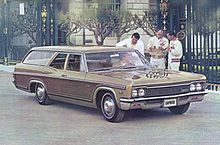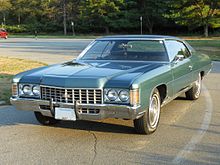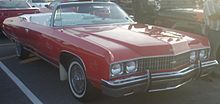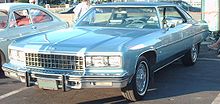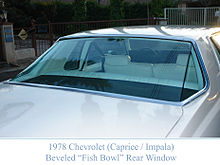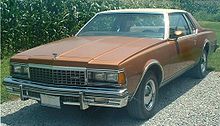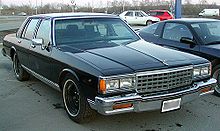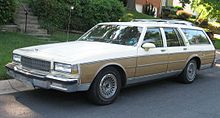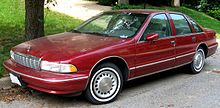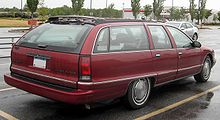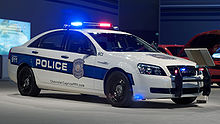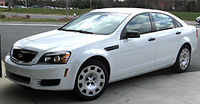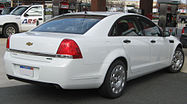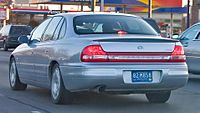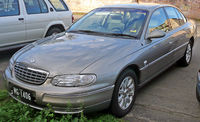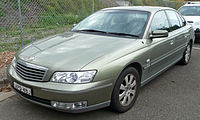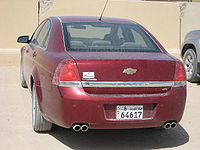- Chevrolet Caprice
-
Chevrolet Caprice 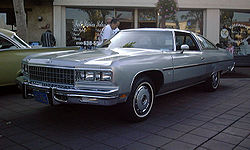
1976 Chevrolet Caprice Classic Landau CoupeManufacturer Chevrolet (1964-1996)
Holden (2011-present)Production 1964–1996 Model years 1965-1996 Class Full-size Layout FR layout Platform B-body (1965–1996) The Chevrolet Caprice is a full-sized automobile produced by the Chevrolet Division of General Motors in North America for the 1965 through 1996 model years. Full-size Chevrolet sales peaked in 1965 with over a million sold. It was the most popular American car in the sixties and early seventies. which during its lifetime included the Biscayne, Bel Air and Impala. Introduced in mid-1965 as a luxury trim package for the Impala four-door hardtop, Chevrolet offered a full line of Caprice models for the 1966 and subsequent model years, including a "formal hardtop" coupe and an Estate station wagon. The 1971 to 1976 models are the largest Chevrolets ever built. The Caprice was renamed Caprice Classic for the 1973 model year, but the Caprice nameplate returned—added in 1986 replacing the Impala. The downsized 1977 and restyled 1991 models were awarded Motor Trend Car of the Year. Production ended in 1996.
In 2011, the Caprice nameplate returned to North America as a full-size, rear wheel drive police vehicle, a captive import from Australia built by GM's subsidiary Holden—the police vehicle is a rebadged version of the Holden Caprice.[1] From 1999 to the present imported Holden Statesman/Caprices built by Holden have been marketed as Chevrolet Caprices in Middle Eastern markets.
Contents
North America
First generation (1965–1970)
1965–1966
First generation 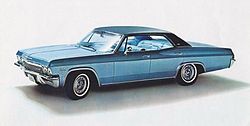
1965 Chevrolet Caprice Custom 4 Door HardtopProduction 1964–1970 Model years 1965-1970 Assembly Atlanta, Georgia, United States
Arlington, Texas, United States
Doraville, Georgia, United States
Flint, Michigan, United States
Framingham, Massachusetts, United States
Janesville, Wisconsin, United States
Lordstown, Ohio, United States
Los Angeles, California, United States
Norwood, Ohio, United State
South Gate, California, United States
St. Louis, Missouri, United States
Tarrytown, New York, United States
Wilmington, Delaware, United StatesBody style 2-door coupe
4-door sedan
4-door station wagonEngine 283 cu in (4.6 L) Small-Block V8
327 cu in (5.4 L) Small-Block V8
396 cu in (6.5 L) Big-Block V8
427 cu in (7.0 L) Big-Block V8
454 cu in (7.44 L) Big-Block V8
307 cu in (5.0 L) Small-Block V8
350 cu in (5.7 L) Small-Block V8
400 cu in (6.6 L) Small-Block V8Transmission 4-speed manual
3-speed manual
2-speed automatic
3-speed automaticRelated Buick LeSabre
Chevrolet Impala
Oldsmobile 88
Pontiac BonnevilleThe Caprice name was coined by Bob Lund (Chevrolet's General Sales Manager) after a classy restaurant he frequented in New York City. Some say the car was named after Caprice Chapman, daughter of auto executive and influential Indy-car official James P. Chapman.
The Caprice was very well received during its abbreviated first year. Essentially a luxury package for the Impala four-door hardtop, the 1965 Caprice included a firmer suspension, higher-grade cloth and vinyl seat and door trim (as well as thicker, higher-grade carpeting), walnut trim on the dashboard and door panels, pull straps on the doors and extra convenience lights. A full vinyl roof was optional.
For 1966, the Caprice was expanded into a full top-line series including a two-door hardtop with a squared-off formal roofline (in contrast to the Impala/SS coupe's fastback roof).
The Caprice Estate, a new station wagon model with simulated woodgrain exterior trim was the first Chevy woodie wagon since 1954. All wagons featured an all-vinyl bench seat interior. A V8 engine was installed in every Caprice. While features such as an automatic transmission, power steering, white sidewall tires, and vinyl top were extra-cost options, virtually every Caprice was built with including them. Although a few Caprices were sold with the new 425 hp (317 kW) 427 cu in (7.0 L) Turbo Jet V8 mated to a four-speed manual transmission, most were built with the more-civilized V8 engines such as the 325 hp (242 kW) 396 cu in (6.5 L) Turbo Jet V8 to handle multitudes of luxury options such as air conditioning, power windows, Cruise-Master speed control, power seats, an automatic headlight dimmer (1965 only) and stereo radios. Several automotive history books noted that a fully optioned Caprice rivaled the appearance, comfort and convenience of the Cadillac DeVille.
The 1966 Caprice featured a revised grille and front bumper, and new rectangular taillights which replaced the Chevrolet-traditional triple round taillights used on Impalas since 1958 with the exception of the "bat-winged" 1959 model. Sedans and coupe models came standard with a luxurious cloth and vinyl bench seats with a folding center armrest in the rear seat. Optional on both was a "Strato bench" seat which combined bucket-style seat backs and center armrest with a bench cushion for six-passenger seating.
Caprices got their own unique standard tire covers, although some of the optional wheels and wheel covers for all big Chevys were also available on the Caprice as well. Cars originally ordered with the optional "mag" wheel covers or "rally" wheels are of particular interest to collectors, as are cars that came from the factory with the optional wood-grained "sport" steering wheels and gauge packages.
New options included the automatic "Comfortron" air conditioning system — the driver could set a constant year-round temperature reading. A "Tilt/Telescopic" steering wheel option could be adjusted vertically in six positions as well as be telescoped further out from the steering column for improved driver comfort. Coupes could also be ordered with an all-vinyl interior featuring Strato bucket seats and center console with floor shifter, storage compartment, courtesy lighting and full instrumentation at the front end of the console that was integrated with the lower instrument panel – in essence a more luxurious Impala SS in a formal-roofed bodyshell.
1967–1968
The 1967 Caprice received a restyling with more rounded body lines and revised grilles and taillights, optional front fender corner lamps which illuminated with the headlamps and a revised instrument panel with round instruments and a new steering wheel. Also new was a dual-master brake cylinder and optional front disc brakes. Other new options included a stereo 8-track tape player, power door locks and a fiber optics monitoring system. The same seating selections continued as before with revisions to trim patterns plus the new addition of all-vinyl upholstery as a no-cost option for conventional and Strato bench seats in sedans and coupes. Engines/transmission offerings were carried over from the previous year. The exception was the optional 425 hp (317 kW) 427 cu in (7.0 L) Turbo Jet V8 was no longer listed, leaving the 385 hp (287 kW) 427 as the top power offering. The three-speed Turbo Hydramatic transmission previously only offered with the 396 cu in (6.5 L) and 427 cu in V8s was now available with the 275 hp (205 kW) 327 cu in (5.4 L) Turbo Fire V8. As with all 1967 cars sold in the U.S., Caprices featured the set of occupant protection safety features including an energy-absorbing steering column, soft or recessed interior control knobs, and belt anchors.
The 1968 Caprice received a minor facelift that included a new grille with taillights set into the bumper and optional hidden headlamps. 1968 Caprice coupes came standard with the new Astro Ventilation system, which included extra vents in the dash, and the removal of vent (wing) windows. Federally mandated side marker lamps became standard on all US cars that year; the Caprice carried over the optional white corner marker lamps at the forward edge of the fenders in addition to the now-required amber parking lights which were illuminated with the headlights. The famous L72 427 cubic-inch 425 hp (320 kW) Turbo Jet was once again available. Also, a new 307 cu in (5.0 L) Turbo Fire V8 rated at 200 hp (150 kW) replaced the 195 hp (145 kW) 283 cu in (4.6 L) small block as the standard engine. Inside, the instrument panel was revised with a return to the horizontal sweep speedometer and a revised three-spoke steering wheel. The horizontal sweep speedometer made adding an optional instrument cluster a difficult proposition; this was solved by narrowing the speedometer within its opening and flanking it with engine-turned instruments in the place of warning lights. The fuel gauge, placed next to the speedometer within its own pod in the base models, was moved to its new place next to the speedometer. A tachometer took the place of the fuel gauge in the large opening left by the fuel gauge.
1969–1970
The 1969 Caprice and other full-sized Chevrolets were restyled with crisper body lines and front bumpers that wrapped around the grille (again with optional concealed headlights, for which headlight washers could be added as a new "one year only" option) along with ventless front windows on all models. The 119-inch (3,023 mm) wheelbase, inner bodyshell and framework were carried over from the 1965 model – along with the rooflines of pillared four-door sedans (which were offered in lesser Impala, Bel Air and Biscayne series, but not on Caprices, which continued only in two- and four-door hardtop choices only). The station wagon was renamed the Kingswood Estate, but continued to use exterior wood grain trim along with exterior and interior trim shared with Caprice sedans and coupes. Inside, front seat headrests were now standard equipment due to a federal safety mandate and the ignition switch moved from the dashboard to the steering column and doubled as a lock for the steering wheel when the key was removed, a Federal mandate that took effect with the 1970 models but introduced a year earlier on all General Motors cars.
The 1969 Caprice also offered a new GM-designed variable-ratio power steering unit as optional equipment along with a seldom-ordered "Liquid Tire Chain" option, which was a vacuum activated button that would spray ice melt on the rear tires (UPC option code is "V75"). The standard engine was enlarged to a 235 hp (175 kW) 327 cu in (5.4 L) V8 with optional engine choices including a new 350 cu in (5.7 L) Turbo Fire V8 rated at 255 and 300 hp (220 kW), a 265 hp (198 kW) 396 cu in (6.5 L) cubic-inch Turbo Jet V8, and 427 cu in (7.0 L) cubic-inch Turbo Jet V8s rated at 335 and 390 hp (291 kW). All V8 engines were now available with the three-speed Turbo Hydramatic transmission for the first time though the two-speed Powerglide was still offered with the 327 and 350 V8s.
The 1970 Caprice received a minor facelift featuring a more conventional under the grille bumper replacing the wrap-around unit used in 1969 along with new triple vertical taillights in the rear bumper. Power front disc brakes and fiberglass-belted tires on 15-inch (380 mm) wheels were made standard equipment along with a larger 250 hp (186 kW) 350 cubic-inch Turbo Fire V8. Optional V8s included a 300 hp (220 kW) 350 and a new 265 hp (198 kW) 400 cu in (6.6 L) Turbo Fire V8. At the top of the engine roster, the big block 427 was replaced by a new (longer stroke) 454 cu in (7.4 L) Turbo Jet V8 offered in power ratings of 345 hp (257 kW) and 390 hp (290 kW). Both the 250- and 265 hp (198 kW) Turbo Fire engines were designed to use regular gasoline while the 300 hp (220 kW) 350 Turbo Fire and both 454 Turbo Jet engines required premium fuel. A three-speed manual transmission with column shift was standard equipment as in previous years but the floor-mounted four-speed manual with Hurst shifter was dropped from the option list for 1970 as were the Strato bucket seats and center console previously offered on coupes. Automatic transmission options included the two-speed Powerglide on 350 V8s and Turbo Hydramatic with all engines.
Second generation (1971–1976)
Second generation 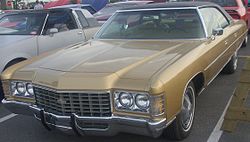
1971 Chevrolet Caprice 4 Door HardtopProduction 1970–1976 Model years 1971-1976 Assembly Arlington, Texas, United States
Oshawa, Ontario, Canada
South Gate, California, United States
Tarrytown, New York, United States
Caracas, Venezuela[2]Body style 2-door hardtop
2-door coupe
4-door hardtop
4-door sedan
4-door station wagon
2-door convertibleEngine 350 cu in (5.7 L) Small-Block V8
400 cu in (6.6 L) Small-Block V8
400 cu in (6.6 L) Big-Block V8
454 cu in (7.4 L) Big-Block V8Related Buick LeSabre
Chevrolet Impala
Oldsmobile 88
Pontiac Bonneville1971–1972
The 1971 Caprice was completely redesigned on a longer 121.5-inch (3,090 mm) wheelbase and featured fuselage styling. Flush exterior door handles and double-shell roofs were new on the Caprice – both features first appearing on the 1970½ Camaro and Pontiac Firebird. The new styling was highlighted by a Cadillac-like "egg-crate" grille with a "Caprice" emblem in the center and brushed metal trim surrounding the taillights on the rear deck.The "Full-Perimeter" frame and all-coil suspension were refined for improvements in ride and noise reduction.
Inside were revised interiors featuring a two-spoke cushioned steering wheel and new instrument panel with horizontal sweep speedometer and instrument placement similar to previous full-sized Chevrolets. Caprices continued with higher grade interiors than their Impala counterparts with luxurious cloth-and-vinyl upholstery, wood grain trim on dash, steering wheel and door panels plus carpeting on lower door panels on both sedans and coupes. A center front seat armrest was also featured on sedans.
Station wagons now used a unique 125-inch (3,200 mm) wheelbase and were larger than ever before. Station wagons continued to use unique model names. The Kingswood Estate wagon was considered to be equivalent to the Chevrolet Caprice being the top level wagon. Unlike previous years, station wagons used unique rear suspension using a solid axle with leaf springs as opposed to coil springs and trailing arms on sedans and coupes. Also new was the "Glide-Away" clam shell style disappearing tailgate. This design had the glass upper portion of the tailgate slide into the roof, and the lower steel portion slide into a compartment under the floor, providing a completely open space with no tailgate in sight.
The cargo capacity was the largest for a Chevrolet wagon, at 106.4 cubic feet (3.01 m3). With 100.5 inches (2,550 mm) from the front seat to the tailgate and 48.8 inches (1,240 mm) between the rear wheels, these wagons could easily carry a 4 × 8 ft (1.2 × 2.4 m) sheet of plywood with the tailgate closed. Kingswood wagons came in two-seat or three-seat versions. The three-seat model had a forward-facing rear seat that was placed over the rear axle area allowing for two additional occupants making them eight-passenger wagons. The Kingswood Estate had the 400 cu in (6.6 L) two-barrel engine as standard with the same engine options as the coupes and sedans. Station wagon models came only with single exhaust systems which meant lesser power ratings than coupes and sedans.
Power front disc brakes were standard equipment, along with a larger 255 horsepower (190 kW) gross (170 hp (130 kW) net) 400 cubic-inch Turbo Fire V8. This engine, along with all optional power plants, were designed to run on regular leaded, low-lead or unleaded gasoline of 91 research octane or higher. To achieve this, all engines had the compression ratios lowered to 8.5:1. General Motors was the first of the big three to have all engines run on regular fuel and these changes were made to help meet the increasingly stringent emission regulations that were to come in to place in years to come.
Optional engines included 300 horsepower (206 net) 400 cubic-inch Turbo Jet V8 (not to be confused with the two-barrel 400 small block this engine actually displaced 402 cu in (6.6 L)) and 365 horsepower (272 kW) gross (285 horsepower (213 kW) net) 454 Turbo Jet V8 which came standard with dual exhaust. When equipped with dual exhaust, the 400 Turbo jet was rated at 260 hp (190 kW). At mid-year, the Turbo Hydramatic transmission and variable-ratio power steering became standard equipment on all Caprice models and lower-line models fitted with a V-8 engine.
Chevrolet specifications included both "gross" and "net" horsepower figures in 1971, which was a year before the industry wide transition to SAE net horsepower figures. SAE net horsepower standardized horsepower ratings in accord with SAE standard J1349 figures to get a more accurate horsepower figure. "Net" horsepower was measured "as installed" in a vehicle with power using accessories and emission equipment installed, exhaust systems, and air cleaners, leading to lower power ratings. For 1971, the 400 Turbo-Jet engine was rated at 300 gross horsepower with and without dual exhaust, while the more accurate net firgures show it rated at 206 hp (154 kW) with single exhaust and 260 with dual exhaust. Beginning in 1972, automakers would follow SAE standard J1349 and the "net" horsepower ratings were the only advertised ratings.
In its May 1971 issue Motor Trend magazine published a comparison road test that included a Caprice Coupe and a Cadillac Sedan de Ville. The tested Caprice was powered by the 454 V8 and loaded with virtually all available options. Though MT noted that the Cadillac had a higher level of quality than the Chevrolet along with a far more luxurious interior (the DeVille was upholstered in leather while the Caprice had the standard cloth trim), the magazine ultimately considered the Chevy as the better value at $5,550.35 compared to the Cadillac's $9,081.00 price mainly due to the fact the $3,500 price difference bought only a modest quality addition and a few more luxury features.
The 1972 Caprice received a facelift with a revised grille that was lower in height than the '71 model flanked by a new bumper with increased protection one year ahead of the Federal mandate. This was done by a bumper within bumper design. Heavy gauge beams reinforced the bumper which are attached to the frame. The rear bumper also featured this design and now had the triple taillights now mounted in the bumper. Engine offerings were carried over from 1971 with the switch to "net" horsepower ratings including 170 hp (127 kW) for the standard two-barrel 400 cu in (6.6 L) Turbo Fire V8, 210 hp (157 kW) (240 hp (179 kW) with optional dual exhaust) for the four-barrel Turbo Jet 400 big-block V8 and 270 hp (201 kW) for the four-barrel dual exhaust 454 cu in (7.4 L) Turbo Jet V8 (rated at 230 hp (172 kW) in wagons with single exhaust). Turbo Hydramatic transmission, variable-ratio power steering and power front disc brakes continued as standard equipment. New to the Caprice lineup was a pillared four-door sedan. All models also featured a revised "Astro Ventilation" system utilizing vents in the doorjams that replaced the troublesome 1971 version that used vents in the trunklid and turned out to be a major source of complaints to Chevy (and other GM divisions) dealers from customers.
1973–1974
The Caprice was renamed the Caprice Classic for 1973, a year highlighted by a new cross-hatch grille over the new 5 mph (8 km/h) energy absorbing front bumper and revised square taillights, again mounted in the bumper. Increasingly stringent emission standards added EGR (exhaust gas recirculation) valves to engines, and accordingly horsepower figures continued to drop. The standard Turbo-Fire 400 cu in (6.6 L) two-barrel was now rated at 150 hp (112 kW) while the only optional engine was the Turbo-Jet 454 cu in (7.4 L) V8 produced 245 hp (183 kW) with dual exhaust (215 hp (160 kW) with single exhaust used in station wagons). A convertible, brought over from the lesser Impala series, was moved to the Caprice lineup for the first time in 1973 and the wood grained-trim station wagon known as the Kingswood Estate since 1969 was renamed the Caprice Estate. A new option on sedans and coupes was a 50/50 bench seat with recliner on the passenger side.
The 1974 models featured a new grille. The taillights were moved above the new 5 mph (8 km/h) rear bumper. New thick "B" pillars and fixed rear quarter opera windows were new on two-door coupes, which essentially eliminated pillar-less hardtop design much like the GM intermediates did the previous year. Other body styles including the four-door pillared and hardtop sedans, convertible and Estate Wagon were carried over with only minor changes from 1973. New to the engine roster was a four-barrel version of the small block 400 cubic-inch Turbo Fire V8 rated at 180 hp (134 kW) (which was the standard engine on wagons and all cars sold in California, optional on other models in 49 states). All other engines were carried over from 1973 although the 454 Turbo Jet lost 10 horsepower (7.5 kW), now rated at 235 hp (175 kW) Also new for 1974 were integrated lap and shoulder seat belts and the unpopular "interlock" system that required the driver and front seat passengers to fasten seat belts in order to start the vehicle. The interlock mandate received so much public outcry that Congress rescinded it shortly after the introduction of the 1975 models. A new option this year was a remote control for the passenger-side outside rear-view mirror.
A dealer group shipped a batch of '74 models to New Zealand where they were converted to right hand drive by Mercury Bay Motors, a country firm on the Coromandel Peninsula.
1975–1976
The 1975 models received a revised grille and taillight trim and six-window styling on four-door models. The dashboard, radio and climate control graphics were revised; the speedometer read up to 100 mph (160 km/h), and had smaller numbers for kilometers per hour. The Caprice convertible would be discontinued after the 1975 model year along with its full-size B-body ragtop counterparts including the Oldsmobile Delta 88, Buick LeSabre and Pontiac Grand Ville. Just about 8,350 Caprice Classic rag tops found buyers in 1975, and both surviving Caprice Classic (1973 to 75) and Impala (1971, 1972) ragtops have demonstrated quite an appreciation in value. This depends on the car's overall condition with a low mileage, unmolested original always being highly coveted by collectors and fans.
As fuel economy became a bigger priority among Americans following the Arab Oil Embargo of late 1973 and early 1974, Chevy made the smaller 145 hp (108 kW) 350 cu in (5.7 L) small block V8 with two-barrel carburetor standard on all Caprice models except wagons for 1975. In California, the four-barrel 155 hp (116 kW) 350 V8 was the base engine and this engine was unavailable elsewhere. Optional engines included the 175 hp (130 kW) 400 cu in (6.6 L) small block V8 (standard on wagons) and 215 hp (160 kW) 454 cu in (7.4 L) big block, the last was not available in California. All engines except for the 454 were single exhaust systems with the introduction of the catalytic converter. Station wagons that used the 454 now featured dual exhaust as well. Also introduced this year were GM's "High Energy" electronic ignition and radial tires that were advertised as part of "Chevrolet's New Efficiency System." The theme of economy continued through to the new options this year: A new "Econominder" gauge package included a temperature gauge and a "fuel econominder", the second being a gauge alerting drivers as to when their driving habits caused the engine to use more or less fuel. Also new on the options list: intermittent windshield wipers, and 50/50 seating options on the Impala coupe/sedan and Caprice Classic convertible models.
"Landau" model was also introduced in 1975, and was primarily an appearance package. Carried over unchanged into 1976, the Landau featured a choice of special paint colors, sports-styled dual remote outside rear-view mirrors, color-keyed wheel covers, a landau vinyl roof (with chrome band across the roof), a vinyl bodyside molding insert, and pinstriping. Inside there were color-keyed seat belts and floor mats. Fender and dashboard emblems rounded out the package. With minor changes, the Landau would be carried over into the 1977-era coupe models.
The 1976 Caprice Classic marked the sixth and final year of a body style introduced for the 1971 model year. 1976 models weighed approximately 4,314 pounds (1,957 kg) and was 222.9 inches (5,660 mm) long, growing considerably from the 1971s 4,040 pounds (1,830 kg) and 216.8-inch (5,510 mm) length. Only minor changes were made for 1976, including an eggcrate grille similar to that of the 1976 Cadillac Calais/DeVille/Fleetwood flanked by new rectangular headlights, along with revised exterior and interior trimmings. Engine options remained virtually unchanged with the 350 two-barrel remained standard in everywhere but California where the 350 four-barrel was standard. The only change was the 350 four-barrel was available in sedans and coupes nationwide and rated at 165 hp (123 kW). The dual exhaust equipped 454 increased 10 hp (7.5 kW), rated at 225 hp (168 kW) and was still unavailable in California. Also available was the 180 horsepower (130 kW) four-barrel 400 V8 standard on wagons and optional on all other models. This was the final year for the big block 454 V8 to be offered, along with hardtop body styles and the clamshell-tailgate design for the station wagon.
Third generation (1977–1990)
Third generation 
1987–89 Chevrolet Caprice 4-door SedanProduction 1976–1990 Model years 1977-1990 Assembly Arlington, Texas, United States
Oshawa, Ontario, Canada
South Gate, California, United States
Detroit, Michigan, United States – Clark Avenue
Flint, Michigan, United States
Janesville, Wisconsin, United States
Caracas, Venezuela[3]Body style 4-door sedan
4-door station wagon
2-door coupeEngine 250 cu in (4.1 L) Chevrolet Straight-6
229 cu in (3.8 L) Chevrolet 90° V6
262 cu in (4.3 L) Chevrolet 90° V6
267 cu in (4.4 L) Small-block V8
305 cu in (5.0 L) Small-block V8
307 cu in (5.0 L) Oldsmobile V8
350 cu in (5.7 L) Small-block V8
350 cu in (5.7 L) Oldsmobile Diesel V8Transmission 3-speed automatic
4-speed automaticWheelbase 116 in (2,946 mm) Length 215.7 in (5,479 mm) (wagon)
212.2 in (5,390 mm) (sedan)Width 79.3 in (2,014 mm) (wagon)
75.4 in (1,915 mm) (sedan)Height 58.2 in (1,478 mm) (wagon)
56.4 in (1,433 mm) (sedan)Related Buick LeSabre
Buick Estate
Oldsmobile Custom Cruiser
Oldsmobile 88
Pontiac Bonneville
Pontiac Parisienne
Pontiac Catalina
Pontiac Laurentian
Pontiac Safari1977–1979
The 1977 Caprice Classic was drastically downsized, which reduced its weight and exterior dimensions, while increasing headroom, rear seat legroom and trunk space compared to 1976 models. GM called its downsizing program Project 77 and invested $600 million to develop the most changed full-size Chevrolet to date. The weight reductions from the 1976 models were 611 lb (277 kg) for coupes, 637 lb (289 kg) for sedans and 871 lb (395 kg) for wagons. The 1977 The Caprice coupe and sedan were over 10 inches (250 mm) shorter while the wagon was 14 inches (360 mm) shorter. Wheelbases were reduced to 116 inches (2,900 mm) from 121.5 inches (3,090 mm) for coupes and sedans and 125 inches (3,200 mm) for wagons. Width was reduced by 4 inches (100 mm) for sedans and coupes; the wagon's width remained virtually unchanged. Heights were increased increased by 2.5 inches (64 mm) and trunk capacities were increased to 20.9 cubic feet (0.59 m3) for sedans and 19.8 cubic feet (0.56 m3) for coupes.
Size comparison between 76 and 77 Caprice .[4][5]
1976 Caprice 1977 Caprice Wheelbase 121.5 in (3,086 mm) 116.0 in (2,946 mm) Overall Length 222.9 in (5,662 mm) 212.1 in (5,387 mm) Width 79.5 in (2,019 mm) 75.5 in (1,918 mm) Height 53.7 in (1,364 mm) 55.3 in (1,405 mm) Front Headroom 38.9 in (988 mm) 39.0 in (991 mm) Front Legroom 42.5 in (1,080 mm) 42.2 in (1,072 mm) Front Hip Room 59.3 in (1,506 mm) 55.0 in (1,397 mm) Front Shoulder Room 63.8 in (1,621 mm) 61.1 in (1,552 mm) Rear Headroom 38.0 in (965 mm) 38.2 in (970 mm) Rear Legroom–ins. 38.8 in (986 mm) 39.5 in (1,003 mm) Rear Hip Room 59.7 in (1,516 mm) 55.7 in (1,415 mm) Rear Shoulder Room 63.8 in (1,621 mm) 61.1 in (1,552 mm) Luggage Capacity 18.9 cu ft (535 L) 20.9 cu ft (592 L) Although by modern standards the 1977 downsized Chevrolet cars are quite large, the new Chevrolet had exterior dimensions closer to the intermediates of its day. In fact the 1977 Caprice shared the same 116-inch (2,900 mm) wheelbase of the intermediate sized Chevrolet Chevelle. The introduction of such a small full-size car was considered quite a risk for General Motors. To help ensure the car was a success, preview clinics were held by Chevrolet which returned very positive results. Furthermore, the design process for this car was revolutionized. No longer would the design be focused towards the longer, lower, wider trend the GM had followed for many years. Designers started with a passenger compartment that had as much or more headroom and overall legroom as the 1976 full-size models and then worked outward to the exterior. Wind tunnel testing was used to help define the shape of the new Chevrolet rather than fix aerodynamic problems that cropped up after the design was completed as in previous years.
Ford would respond with advertising the Ford LTD traditional full-size attributes. In 1979 Ford released a true downsized full-size car with the introduction of the 1979 Ford LTD. Chrysler responded in 1979 when it re-engineered its intermediate B-body cars, and designated them the full-size R-bodies. However, these were not true downsized cars like GM and Ford introduced. 1977 models included a four-door sedan, two-door sedan, six-passenger two-seat station wagon and an eight-passenger three-seat station wagon. All models had window framed doors. No hardtop models were offered.
Two-door models featured a unique rear window that created a semi-fastback. This glass had sharp corners giving it three sides. This was done through "hot-wire" bending process. The Caprice was available as the sport coupe or as the Landau coupe. The Landau coupe featured a partially covered vinyl roof.
Station wagon models received a new three-way tailgate for 1977; the clamshell tailgate was gone. The three-seat models featured a rear-facing third seat for two occupants making these cars eight-passenger models. The cargo capacity was reduced to 87 cubic feet (2,500 L), and although the station wagon could still carry a 4 × 8 ft (1.2 × 2.4 m) sheet of plywood, this could now only be done with the tailgate down. Station wagons used the coil spring suspension in the rear, like the sedans and coupes.
All 1977 models were named Caprice Classics. A V8 engine was no longer standard equipment for the first time since 1965. The base engine for 1977 Chevrolet Caprice coupes and sedans was Chevy's long-running 250 cu in (4.1 L) six-cylinder powerplant rated at 110 hp (82 kW). This engine was last available in a full-size Chevy in 1973 in the lower-line Bel Air. Standard on station wagons and optional on other Caprice models was a 145 hp (108 kW) 2-barrel 305 cu in (5.0 L) version of the Chevy's small-block V8. This was the first year the 305 cu in had been used in a full-size Chevrolet; it was first introduced in 1976 in compact and mid-sized Chevrolet lines. A 170 hp (127 kW) 350 cu in (5.7 L) V8 with four-barrel carburetor was now the top engine offering as the larger 400 cu in (6.6 L) and 454 cu in (7.4 L) V8s were discontinued.
With the new lighter weight and smaller engines, Chevrolet promised increase fuel economy without great loss of performance compared to 1976 models. The EPA estimates for 1977 Chevrolet was 17 miles per US gallon (14 L/100 km; 20 mpg-imp) city and 22 miles per US gallon (11 L/100 km; 26 mpg-imp) highway for six-cylinder models. Ford's 1977 LTD was rated at 15 miles per US gallon (16 L/100 km; 18 mpg-imp) city and 19 miles per US gallon (12 L/100 km; 23 mpg-imp) highway with its smallest engine, the 302 cu in (4.9 L) V8. By the same EPA estimates, Plymouth's Gran Fury returned 13 MPG city and 18 MPG highway with the 318 V8. Performance was good when comparing the smaller 1977 Caprice to the 1976 Caprice. A 1976 350 two-bbl powered Chevrolet ran 0–60 in 12.9 seconds, while a 400 powered model ran 10.7 seconds. 1977 models ran 11.4 seconds to 60 mph (97 km/h) with the 305 engine and 10.8 seconds with the 350 engine. Car and Driver tested a 1977 Chevrolet Impala with the 350 engine and 3.08:1 axle running a 9.6 second 0–60 time and obtaining a 117 mph (188 km/h) top speed. The 350 was available with a 2.56:1 axle ratio and a 3.08 axle ratio which may explain the difference in performance times.
The 1977 models became the number one selling car in the United States. (In 1976, the previous generation full-size Chevrolet was the third best seller). More than 660,000 full-size Chevrolets were produced for the 1977 model year, with the most popular model the four-door Caprice Classic sedan (212,840 produced). By 1978 more than 1 million downsized Chevrolets had been produced. Auto publications agreed with the public reception.
Motor Trend awarded the 1977 Chevrolet Caprice Car of the Year.
Car and Driver declared "Even the most jaded car critics are in fact tripping over each other trying to be the first to anoint this sedan to be the best full-sized Chevrolet ever made." Car and Driver commented on the F41 suspension option which included stiffer springs, larger sway bars wheels and tires to say, "It will make you think your Chevy came from the Black Forest instead of Detroit."
1978 models had minor front and rear styling revisions. The engine line-up remained unchanged, but numerically lower axle ratios were used in an attempt to boost fuel economy. The 305 and 350 engines went from a standard 2.56:1 axle in 1977 (2.73:1 for wagons), to a 2.41:1 axle in 1978 (2.56:1 for wagons). An optional 3.08 axle was also available for 350 powered Caprices. The 305 V8 engine received an aluminum intake manifold which reduced engine weight by 35 pounds. A larger brake booster was also added to help reduce braking effort. New options included a steel sliding moonroof and 40-channel CB radio built into the AM/FM radio.
The 1979 models continued with only minor refinements. Again the front and rear styling was refreshed slightly. The 250 six gained five horsepower, while the 305 V8 lost 15 horsepower (11 kW). The change to the 305 was a result of switching from the larger Rochester 2GC carburetor to the smaller Rochester Dualjet carburetor. The 350 engine was unchanged.
1980–1985
The 1980 Caprice Classic saw its first major revision since the 1977 downsizing. To further improve the fuel economy of the car, efforts were made to reduce weight and improve aerodynamics. The Caprice received all new exterior sheet metal, without drastically changing the look of the car. To improve aerodynamics the hood was tapered lower, while the trunk area was higher. The grille was now an egg crate style while the tail-light panel featured three separate square lights per side. All the doors and components within were redesigned to be lighter, including the window crank mechanisms, which now used a tape drive mechanism. Greater use of aluminum including in bumper reinforcement and in sedan/coupe radiators helped to further reduce the overall weight of the vehicle. 1980 models were approximately 100 pounds (45 kg) lighter than 1979 models.
The new styling increased the trunk capacity of both coupes and sedans to 20.9 cubic feet (0.59 m3). This increase was also partially achieved with a now standard compact spare tire on a 16-inch (410 mm) wheel. A new frame lift jack replaced the bumper mounted model. A larger 25 US gallons (95 l; 21 imp gal) fuel tank was standard equipment in sedans and coupes. Easy-roll radial tires, improved anti-corrosion measures, low friction ball joints and larger front suspension bushings were also new for 1980. Puncture-sealant tires and cornering lights were new options.
The 250 cu in (4.1 L) six, was replaced by a new 90 degree Chevrolet 3.8 L (229 cu in) V6 as the base engine for sedans and coupes. This engine shared the same bore and stoke as the 305 cu in V8. California emission cars used the Buick 3.8 L (231 cu in) V6 engine. The Chevrolet 3.8 L was rated at 115 hp (86 kW) while the Buick V6 engine had a 110 hp (82 kW) rating. Although the 3.8 L V6 had the same horsepower rating as the 250 six used in 1979, the 250 had 25 ft·lbf (34 N·m) more torque than the 3.8 L (200 ft·lbf vs 175 ft·lbf). The 3.8 L V6 did boost Chevrolet Caprice's fuel economy to and EPA estimated 20 miles per US gallon (12 L/100 km; 24 mpg-imp) city and 29 miles per US gallon (8.1 L/100 km; 35 mpg-imp) highway, the highest a full-size Chevrolet had been rated to date.
The base V8 engine was new for 1980. The 4.4 L 267 cu in V8 rated at 115 hp (86 kW) and was the standard engine for station wagons. This engine had a 2-barrel carburetor Rochester Dualjet carburetor, and was not available in California. The 2-barrel carburetor on the 305 cu in (5.0 L) V8 was replaced with a four-barrel increasing the 305's output to 155 hp (116 kW). This was now the most powerful engine option (standard on California station wagons), as the 350 cu in (5.7 L) V8 was no longer available, except as part of the police package option. The Oldsmobile-built 350 cu in Diesel V8 was added to the option list for station wagons. This engine was rated at 105 hp (78 kW) and 205 lb·ft (278 N·m). To further increase fuel economy, all transmissions were equipped with an electronically controlled lock-up torque converter clutch.
1981 models saw only minor revisions. Styling was unchanged other than the grille which remained egg crate style but now had larger sections. Refinements included redesigned front disc brakes for less drag and a translucent plastic master cylinder reservoir. The cruise control became equipped with a resume feature, while wire wheel covers had locking bolts to secure them in place.
The engine line-up remained unchanged, although the 3.8 L 229 cu in V6 was now rated at 110 hp (82 kW) and the 5.0 L 305 cu in V8 was rated at 150 hp (112 kW). All engines were updated with the Computer Command Control (CCC) system which included an electronically metered carburetor. This change occurred in 1980 for California emission cars and did not occur to Canadian emission cars until 1987. A new four-speed automatic overdrive transmission with lock-up torque converter joined the powertrain line-up. This transmission helped boost highway fuel economy, while improving city performance by with a 3.08:1 rear axle ratio. The overdrive transmission was only available with the 305 cu in V8, and was a mandatory option for this engine.
1982 models saw only minor styling revisions. The model line-up was reduced by one, with the Caprice Landau coupe dropped. Remaining were the sedan, sport coupe, six-passenger wagon and the eight-passenger wagon.
The engine line-up and power ratings remained unchanged. The 350 cubic-inch Diesel V8 engine was now available on all models. The automatic overdrive transmission was available with both the 267 cu in (4.4 L) V8 and the 305 cu in V8 engine. This transmission was no longer a mandatory option for the 305 cu in engine, which now came standard with the three-speed automatic (except for California models).
1983 was marked with the fewest models to date. No two-door models were produced, leaving only the four-door and the eight-passenger station wagon, since the 6-passenger wagon also left the line-up. The 4.4 L 267 cu in engine was discontinued, but all other engines remained unchanged. The 305 cu in engine and the automatic overdrive transmission was standard on station wagons. The 350 cu in diesel was available with the automatic overdrive transmission at extra cost, while the 305 cu in V8 came equipped only with the automatic overdrive transmission. The 1983 Chevrolet Caprice Classic was selected on the Car and Driver Ten Best list.
The 1984 model year saw the return of the two-door sport coupe making a three model line-up. Styling remained unchanged. 1984 models were virtually identical to 1981 models. The windshield washer controls were moved from the dashboard to the turn signal stalk to create the multi-stalk. The optional cruise control (which continued to be mounted on the turn signal stalk) now featured acceleration/deceleration in 1 mph (1.6 km/h) increments. An optional Landau package included a vinyl roof, sport mirrors and reveal moldings.
Powertrain availability and power ratings were unchanged for 1984. The 350 cu in diesel engine came standard with an automatic overdrive transmission when equipped in station wagons.
1985 models received minor updates while styling remained unchanged. The interior was updated for 1985, marking its most significant update since 1977. The simulated woodgrain appliqué used on the dash was replaced with a simulated silver metallic appliqué. The shaft-style radio was replaced with a more modern DIN-and-a-half style radio, while the pull-out headlight switch was replaced by a push button style switch. The climate controls were updated with rotary switches for the fan and rear window defroster replacing the toggle style switches. The instruments were updated to have a more modern appearance, with a horizontal speedometer while a round speedometer was included with the optional gauge package.
The engine line-up saw major changes for 1985. The 4.3 L V6 engine (262 cu in) with throttle body fuel injection (RPO LB4) replaced both 3.8 L V6s in 1985 as the base engine for sedans and coupes. The 4.3 L engine was rated at 130 hp (97 kW) and 210 lb·ft (285 N·m), producing 20 hp (15 kW) more than the 229 cu in V6. The 4.3 L V6 shared its bore and stroke with the 350 cu in Chevrolet V8. This engine came standard with a three-speed automatic but was available with the four-speed automatic overdrive transmission. The 5.0 L 305 cu in V8 engine received an electronic spark control and compression was increased from 8.6:1 to 9.5:1. This caused the 305's output to jump to 165 hp (123 kW). The 350 cu in diesel engine remained unchanged, as it was dropped in January.
1986–1990
1986 marked the first major exterior restyle since 1980. The front fascia was restyled to have a more aerodynamic look. The Caprice emblem was still a hood ornament, directly in the center at the front of the hood. A new smaller sleeker grille with prominent vertical chrome divider bars replaced the egg crate style used in 1985. The rear tail lights were restyled to look more modern and detailed, but continued to have three lights per side. The sheet metal remained unchanged, however the new front and rear restyles updated the appearance of the Caprice.
With the Impala no longer being produced, a new base Caprice four-door model was introduced (similar to the previous Impala). Still available was a four-door sedan, coupe and eight-passenger station wagon, while a new Brougham four-door sedan joined the model line-up. Brougham models featured a 55/45 front seat with armrest, and a new "pillow design" with velour fabrics. Broughams featured woodgrain appliqué on its dash fascia, a dome map light, front door courtesy lights and 20-oz carpeting. Power window controls for all model moved from the door panel to the armrest for improved ergonomics.
The 4.3 L V6 engine received a 10 hp (7.5 kW) boost, rated at 140 hp (100 kW). The 305 cu in engine was unchanged and remained standard on station wagons. Station wagons built after approximately November 1, 1985 came equipped with the Oldsmobile-built 307 cu in engine. After this point the 305 cu in was no longer available in station wagons. This engine was used in all GM b-body station wagons from this point on to simplify production. The 307 cu in was equipped with a four-barrel carburetor and was rated at 140 hp (104 kW) and 255 lb·ft (346 N·m). The 350 cu in diesel engine was discontinued.
The 1987 models saw only minor styling revisions after the restyling of the previous year. All models came equipped with new modern composite headlights and a stand-up hood ornament returned. A woodgrain applique was used on the dashboards for all models. The model line-up was slightly revised, and now included a base level Caprice 8-passenger wagon, and a Caprice Classic Brougham LS 4-door sedan. The Brougham LS featured all the Brougham amenities, plus a padded vinyl roof, opera lights and LS monograms. Leather upholstery was a new available option for Brougham and Brougham LS sedans, which also had a new pillow-style seating design and a folding center armrest in the back seat.
The engine line-up received only minor changes. The 4.3 L V6 and the 305 cu in V8 were updated with roller lifters and center bolt valve covers. The 305 cu in had a 5 hp (3.7 kW) rating increase and was now rated at 170 hp (127 kW) and 250 lb·ft (339 N·m). The 307 cu in Oldsmobile built V8 remained unchanged and was the only available engine for the station wagons. Some Canadian sold Chevrolet Caprice sedans used the 307 cu in Oldsmobile built V8 in place of the Chevrolet built 305 cu in engine during the 1987 model year.
The 1988 model line-up was revised, with sport coupe dropped due to low sales. The station wagon line-up was reduced to one model, eight-passenger wagon. Engines remained unchanged, but the four-speed automatic overdrive transmission was standard on all engines and models. Standard equipment for all models included tinted glass, a remote control drivers mirror, automatic headlight on/off, and an AM/FM stereo.
1989 marked the first year of a fuel injected V8 engine. The Ford LTD Crown Victoria had been equipped with fuel injection on its V8s since 1983. The 305 cu in V8 was updated with throttle body electronic fuel-injection (RPO LO3), first introduced in 1987 on Chevrolet/GMC pickups and vans. This engine was rated at 170 hp (127 kW) and 255 lb·ft (346 N·m), which was only a slight increase in torque over the carbureted engine. However, the cold weather starts, drivability, fuel economy and emissions were all improved as a result of fuel injection. The 4.3 L V6 was no longer the base engine, and was now only available in Taxi and Police optioned Caprices. The 307 engine remained unchanged for station wagons. Rear seat passengers received shoulder belts for the outboard positions and air conditioning was standard on all models.
1990 was essentially a carryover year and marked the last year for the downsized body style. New for 1990 were door mounted front seat belts, quick connect fuel lines for the 305 cu in engine, and Scotchgard protected interior fabrics. The door mounted belts were installed to meet Federal Government passive restraint requirements for the 1990 model year. The model line-up and engine line-up were unchanged. The 1990 Caprice was only produced until the end of 1990 when production was shut-down to prepare for the redesigned 1991 models.
Fourth generation (1991–1996)
Fourth generation 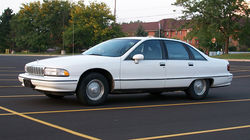
1991 Chevrolet Caprice Classic sedanProduction April 12th 1990 – December 13th 1996 Model years 1991-1996 Assembly Arlington, Texas, United States
Ypsilanti, Michigan, United StatesBody style 4-door sedan
4-door station wagonEngine 4.3 L L99 V8
5.0 L L03 V8
5.7 L L05 V8
5.7 L LT1 V8Transmission 4-speed automatic Wheelbase 115.9 in (2,944 mm) Length 217.3 in (5,519 mm) (wagon)
214.1 in (5,438 mm) (sedan)Width 79.6 in (2,022 mm) (wagon)
77 in (1,956 mm) (1991–93 sedan)
77.5 in (1,969 mm) (1994–96 sedan)Height 60.8 in (1,544 mm) (1991–93 wagon)
60.9 in (1,547 mm) (1994–96 wagon)
55.7 in (1,415 mm) (sedan)Related Chevrolet Impala SS
Buick Roadmaster
Cadillac Fleetwood
Oldsmobile Custom CruiserThe 1991 model was completely restyled — It replaced the 1977-based rectilinear design with rounded, more aerodynamic sheetmetal. While the body and interior were all new, excluding the Anti-Lock Braking System — the chassis and powertrain were carried over from April 1990.[6] and several major components (including the floor pan) are entirely interchangeable between 1977 and 1996.
Motor Trend awarded the new Caprice Classic Car of the Year. Two trim levels were initially offered - Caprice and Caprice Classic, replacing the previous Classic and Brougham models. General Motors had hoped to regain the top spot as America's favorite automobile with the new aerodynamic styling of their full-size offering.
The last-generation Caprice was not well received by critics[citation needed] and did not hold on to high sales numbers. The car's styling was criticized with car aficionados calling it a "beached whale"[7][8] and "an upside-down bathtub"). For 1993 there were some revisions, the most obvious being the removal of the skirted rear wheel wells in favor of more conventional, open wheel wells. This applied only to the sedan model; station wagons retained the skirted wheel wells. In 1995 minor modifications were made to the C-pillars
In 1994 the Caprice received the new-generation GM engines, including an optional detuned version of the Corvette's LT1 350 cu in (5.7 L) engine that put out 260 hp (194 kW) and 330 ft·lbf (447 N·m) of torque. The standard engine in all sedans, including the 9C1 police cars, was the 200 hp (150 kW), L99 263 (4.3 L) V8. The LT1 was optional in the 9C1 police-package and standard in the wagon. The LT1 350 was standard in the civilian sedans, with the addition of the B4U towing package. The towing package also gave a heavy duty suspension nearly identical to the 9C1 police car suspension. 2.93 gears, heavy duty cooling, heavy duty rear drum brakes and positraction were standard with the towing package. The 265 (4.3 L) L99, and 350 (5.7 L) LT1 look nearly identical externally. Many 4.3 L99 equipped sedans are passed off as 5.7 LT1 cars. The 8th digit in the VIN number is the Engine code. W: 4.3 L L99, P: 5.7 L LT1. The 1994 Caprice's interior had a redesign which featured a Camaro steering wheel, digital speedometer and a new console.
The Caprice 9C1 with the LT1 engine became one of the fastest and most popular modern day police vehicles. This vehicle established such strong devotion by many police departments that a cottage industry thrived in refurbishing Caprices for continued police service after GM discontinued production of the car.[9]
The car's production was stopped in 1996 from sales pressure from the mid-size Chevrolet Lumina, financial troubles at General Motors and consumer demand shifting from full-sized family sedans to the increasingly popular sport utility vehicles. The Arlington, Texas vehicle assembly plant (used for Caprices, Buick Roadmaster, Oldsmobile Custom Cruiser, and Cadillac Fleetwood) use moved to produce the higher profit margin SUVs GMC Denali and Yukon, Chevrolet Tahoe and Suburban, and Cadillac Escalade and Escalade EXT. In 1997, the Lumina LTZ would take the Caprice's place as Chevrolet's premium passenger car. Total production of 1991-96 models was 689,257 with production ending on December 13, 1996.[10]
Aftermath
With the exit of the Caprice, the Ford Crown Victoria and its corporate siblings (Mercury Grand Marquis and Lincoln Town Car), continued as the sole traditional rear-drive, body-on-frame, V8-powered American sedans. Thereafter the Crown Vic. dominated police vehicle sales. Dodge would introduce the unibody Dodge Charger in 2006, the division's first rear-wheel drive sedan since 1989.
The Chevrolet Impala name badge was reintroduced to the American passenger car market in 2000 as the marque's premium offering, albeit in a front wheel drive configuration.Captive import (2011–)
Captive import/Fifth generation 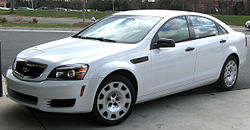
Manufacturer Holden Production 2010-present Model years 2011-present Assembly Elizabeth, South Australia, Australia Body style 4-door sedan Platform GM Zeta platform Engine 3.6 L LFX V6 (224 kW (301 hp))
6.0 L L77 V8 (265 kW (355 hp))Transmission 6-speed 6L45 automatic
6-speed 6L80 automaticWheelbase 3,010 mm (118.5 in) Length 5,187 mm (204.2 in) Width 1,900 mm (74.8 in) Height 1,491 mm (58.7 in) Related Holden Caprice
Pontiac G8
Holden UteOn October 5, 2009, General Motors announced the Chevrolet Caprice Police Patrol Vehicle (PPV).[11] It is being sold to law enforcement agencies in the U.S. and Canadian market as of 2011. Some dealers have been reported to be offering the car to regular customers.[12][13] To be imported from Australia, the new Caprice will be a captive import of the Holden Caprice, as opposed to the Pontiac G8 which was based on the short-wheelbase Holden Commodore version. However, Holden is able to produce the patrol car in short-wheelbase form as it is a main patrol car in Australia in this configuration.[14] Holden will initially outfit the Caprice with the 6.0 L L76 AFM V8, although a 3.6 L LLT SIDI V6 engine will be available nine months later.[15] [16]Both engines will be E85 ethanol-capable.[14] According to Motor Trend The Caprice will replace the Impala for the 2015 model year.
Special features will be added by Chevy for the Caprice Police Patrol Vehicle (PPV). The driver's seat will have a special indentation made to accommodate a police officer's equipment belt so it will be more comfortable to drive. Special tuning such as Performance Algorithm Liftfoot (PAL) calibration and a performance-tuned adjustable suspension will be added for increased performance meant specifically for police needs.[17]
Previously, the future of Holden's North American export program had been the subject of contradictory announcements as General Motors emerged from bankruptcy. On July 11, 2009, Bob Lutz declared the Commodore-based Pontiac G8 "too good to waste" and indicated it would return as a Chevrolet Caprice.[18][19] However, it was undisclosed as to whether the revived Caprice was to be based on the short-wheelbase Holden Commodore (like the Pontiac G8) or the extended length Holden Caprice, like the Middle Eastern Chevrolet Caprice.[20] Several days later, Lutz retracted his comment, citing market conditions,[21] while GM CEO Frederick Henderson confirmed that police applications were being studied.[22]
The Caprice police car has had a positive reception, scoring perfect scores in an assessment by The Los Angeles County Sheriff's Department, with the only criticism being directed at over-cautious electronic stability control.[23]
Engines
Engines for United States models Generation Years Engine Power Torque Fuel Exhaust Notes I 1965–1967 283 cu in Small-Block V8 1965–1969 327 cu in Small-Block V8 1965–1969 396 cu in Big-Block V8 1966–1969 427 cu in Big-Block V8 1968 307 cu in Small-Block V8 1969–1970 350 cu in Small-Block V8 1970 400 cu in Small-Block V8 II 1971 400 cu in Small-Block V8 255 hp (190 kW) 390 lb·ft (529 N·m) 2-bbl single 1971 400 cu in Big-Block V8 300 hp (224 kW) 400 lb·ft (542 N·m) 4-bbl single/dual 1971 454 cu in Big-Block V8 365 hp (272 kW) 465 lb·ft (630 N·m) 4-bbl single/dual 1972 400 cu in Small-Block V8 170 hp (127 kW) 325 lb·ft (441 N·m) 2-bbl single 1972 400 cu in Big-Block V8 210 hp (157 kW) 320 lb·ft (434 N·m) 4-bbl single 1972 400 cu in Big-Block V8 240 hp (179 kW) 345 lb·ft (468 N·m) 4-bll dual 1972 454 cu in Big-Block V8 230 hp (172 kW) 360 lb·ft (488 N·m) 4-bbl single 1972 454 cu in Big-Block V8 270 hp (201 kW) 390 lb·ft (529 N·m) 4-bbl dual 1973 400 cu in Small-Block V8 150 hp (112 kW) 295 lb·ft (400 N·m) 2-bbl single 1973 454 cu in Big-Block V8 215 hp (160 kW) 345 lb·ft (468 N·m) 4-bbl single 1973 454 cu in Big-Block V8 245 hp (183 kW) 375 lb·ft (508 N·m) 4-bbl dual 1974 400 cu in Small-Block V8 150 hp (112 kW) 295 lb·ft (400 N·m) 2-bbl single n/a CA 1974 400 cu in Small-Block V8 180 hp (134 kW) 290 lb·ft (393 N·m) 4-bbl single std CA, wagon 1974 454 cu in Big-Block V8 235 hp (175 kW) 360 lb·ft (488 N·m) 4-bbl dual n/a CA 1975 350 cu in Small-Block V8 145 hp (108 kW) 250 lb·ft (339 N·m) 2-bbl single n/a CA 1975 350 cu in Small-Block V8 155 hp (116 kW) 250 lb·ft (339 N·m) 4-bbl single CA only 1975 400 cu in Small-Block V8 175 hp (130 kW) 305 lb·ft (414 N·m) 4-bbl single 1975 454 cu in Big-Block V8 215 hp (160 kW) 350 lb·ft (475 N·m) 4-bbl dual n/a CA 1976 350 cu in Small-Block V8 145 hp (108 kW) 250 lb·ft (339 N·m) 2-bbl single n/a CA 1976 350 cu in Small-Block V8 165 hp (123 kW) 260 lb·ft (353 N·m) 4-bbl single 1976 400 cu in Small-Block V8 175 hp (130 kW) 305 lb·ft (414 N·m) 4-bbl single 1976 454 cu in Big-Block V8 225 hp (168 kW) 360 lb·ft (488 N·m) 4-bbl dual n/a CA III 1977–1979 250 cu in Chevrolet Straight-6 110 hp (82 kW) 195 lb·ft (264 N·m) 1-bbl single 1977–1978 305 cu in Small-Block V8 145 hp (108 kW) 245 lb·ft (332 N·m) 2-bbl single 1977–1979 350 cu in Small-Block V8 170 hp (127 kW) 270 lb·ft (366 N·m) 4-bbl single 1979 305 cu in Small-Block V8 130 hp (97 kW) 245 lb·ft (332 N·m) 2-bbl single 1980–1984 229 cu in Chevrolet V6 110 hp (82 kW) 170 lb·ft (230 N·m) 2-bbl single n/a CA 1980–1984 231 cu in Buick V6 110 hp (82 kW) 190 lb·ft (258 N·m) 2-bbl single CA only 1980–1982 267 cu in Small-Block V8 115 hp (86 kW) 200 lb·ft (271 N·m) 2-bbl single n/a CA 1980 305 cu in LG4 Small-Block V8 155 hp (116 kW) 240 lb·ft (325 N·m) 4-bbl single 1980–1985 350 cu in LF9 Oldsmobile Diesel V8 105 hp (78 kW) 205 lb·ft (278 N·m) FI single 1980–1988 350 cu in LM1 Small-Block V8 4-bbl single Police 1981–1984 305 cu in LG4 Small-Block V8 150 hp (112 kW) 240 lb·ft (325 N·m) 4-bbl single 1985 262 cu in Chevrolet V6 130 hp (97 kW) 210 lb·ft (285 N·m) TBI single 1985–1986 305 cu in LG4 Small-Block V8 165 hp (123 kW) 245 lb·ft (332 N·m) 4-bbl single 1986–1988 4.3 L/262 cu in Chevrolet V6 140 hp (104 kW) 225 lb·ft (305 N·m) TBI single 1986–1990 5.0 L/307 cu in LV2 Oldsmobile V8 140 hp (104 kW) 255 lb·ft (346 N·m) 4-bbl single 1987–88 5.0 L/305 cu in LG4 Small-Block V8 170 hp (127 kW) 250 lb·ft (339 N·m) 4-bbl single 1989–1990 4.3 L/262 cu in Chevrolet V6 140 hp (104 kW) 225 lb·ft (305 N·m) TBI single police 1989–1990 5.0 L/305 cu in LO3 V8 170 hp (127 kW) 255 lb·ft (346 N·m) TBI single 1989–1990 5.7 L/350 cu in LO5 Small-Block V8 190 hp (142 kW) 285 lb·ft (386 N·m) TBI single police IV 1991–1993 5.0 L/305 cu in LO3 Small-Block V8 170 hp (127 kW) 255 lb·ft (346 N·m) TBI single 1991 5.7 L/350 cu in LO5 Small-Block V8 195 hp (145 kW) 295 lb·ft (400 N·m) TBI single police 1992–1993 5.7 L/350 cu in LO5 Small-Block V8 180 hp (134 kW) 300 lb·ft (407 N·m) TBI single LTZ/wagon 1992–1993 5.7 L/350 cu in LO5 Small-Block V8 205 hp (153 kW) 300 lb·ft (407 N·m) TBI single police 1994–1996 4.3 L/263 cu in L99 Small-Block V8 200 hp (149 kW) 235 lb·ft (319 N·m) MPFI single 1994–1996 5.7 L/350 cu in LT1 Small-Block V8 260 hp (194 kW) 330 lb·ft (447 N·m) MPFI dual std, wagon 1994–1996 5.7 L/350 cu in LT1 Small-Block V8 260 hp (194 kW) 330 lb·ft (447 N·m) MPFI dual police Captive import 2011–present 3.6 L/217 cu in LFX V6 301 hp (224 kW) 265 lb·ft (359 N·m) dual police 2011–present 6.0 L/364 cu in L77 V8 355 hp (265 kW) 384 lb·ft (521 N·m) dual police Middle East
First generation (1999–2006)
Main article: Holden CapriceGeneral Motors revived the Chevrolet Caprice nameplate in the Middle East markets on imported Holden Statesman/Caprice built by its Australian subsidiary Holden. The WH series Statesman/Caprice was the first series to be engineered to support both left- and right-hand drive (Middle Eastern market being LHD while Australia right-hand drive) in order to allow for manufacturing of export versions. Same was true for the related short-wheelbase Holden VT Commodore, whose left-hand drive version became the Chevrolet Lumina in the Middle East.
The Middle Eastern Caprice came out in 2000 in four versions, base LS, standard mid-range LTZ, a sporty SS and the range topper Royale (introduced in 2002). Differences between the models were mostly equipment and slight styling tweaks. The base LS came with a 3.8 L V6 engine; the LTZ came standard with a 220 kW (295 hp) 5.7 L Gen III V8, the SS and Royale came with a 242 kW (325 hp) version of the same engine. In 2003, Holden launched a revised and facelifted Statesman and Caprice, which was reflected in their Middle Eastern versions for the 2004 model year. The new models sported new front and rear fascias and completely redesigned interior. Engines carried over unchanged.
In the 1970s, the Chevrolet Caprice name was also used in South Africa for a version of the Holden's Statesman.[24]
Second generation (2006–present)
Main article: Holden WM CapriceIn November 2006, a completely redesigned Caprice lineup was launched, again based on the recently introduced Holden WM Statesman/Caprice. The new Caprice lineup includes the base LS, LTZ, SS and Royale, all sporting the new 268 kW (360 hp) L98 6.0 L V8. The Holden-sourced Chevrolet Caprice is used in Middle East police forces such as the Royal Oman Police, and Dubai Police Force.
See also
References
- ^ chevroletcapriceppv.com
- ^ "1978 CHEVROLET CAPRICE CLASSIC (VE)". Dkarros.com. http://dkarros.com/es/index.php?option=com_content&view=article&id=380:1978-chevrolet-caprice-classic&catid=14:1970&Itemid=15. Retrieved 2010-05-25. (Spanish)
- ^ "1979 CHEVROLET CAPRICE CLASSIC (VE)". Dkarros.com. http://dkarros.com/es/index.php?option=com_content&view=article&id=379:1979-chevrolet-caprice-classic&catid=14:1970&Itemid=15. Retrieved 2010-05-25. (Spanish)
- ^ "1976_Chevrolet_Full_Size-10". http://www.oldcarbrochures.com/main.php?g2_itemId=25989. Retrieved 2010-01-04.[dead link]
- ^ "1977_Chevrolet_Police-03". http://www.oldcarbrochures.com/main.php?g2_itemId=26380. Retrieved 2010-01-04.[dead link]
- ^ Sanow, Edwin J. Chevrolet Police Cars (Iola, WI: Krause Publications, Inc 1997), p.166.
- ^ Anonymous. "Chevrolet Caprice". www.conceptcarz.com. http://www.conceptcarz.com/vehicle/z12088/Chevrolet-Caprice.aspx. Retrieved 2009-12-29.
- ^ Alex Taylor III (1997-04-28). "GM: Time to Get in Gear". www.CNNMoney.com. http://money.cnn.com/magazines/fortune/fortune_archive/1997/04/28/225531/index.htm. Retrieved 2009-12-29.
- ^ Pat Clason (6 November 1997). "Police keep beloved Caprice and save money". Chicago Tribute: p. 3. "The trend to restore Caprices began in 1995 when Shaheen Chevrolet of Lansing, Mich., refurbished the first of 918 squad cars for law agencies nationwide.."
- ^ The Encyclopedia of American Cars, 2006 Edition
- ^ Wert, Ray (2009-10-05). "EXCLUSIVE: The Chevy Caprice Police Car Is Back!". Jalopnik. Gawker Media. http://jalopnik.com/5373645/exclusive-the-chevy-caprice-police-car-is-back. Retrieved 2009-10-05.
- ^ G. Chambers Williams III (2011-07-09). "Caprice starting to patrol streets". MySanAntonio. http://www.mysanantonio.com/business/business_columnists/g_chambers_williams_iii/article/G-Chambers-Williams-III-Caprice-starting-to-1456685.php.
- ^ "Chevy Caprice Reports for Civic Duty". MotorTrend. September 2011. http://www.motortrend.com/features/auto_news/2011/1109_chevy_caprice_reports_for_civic_duty/.
- ^ a b Pettendy, Marton (2009-10-05). "Official: Holden to export Commodore as US police car". GoAuto. John Mellor. http://www.goauto.com.au/mellor/mellor.nsf/story2/4DB981DD3B661FE0CA25764600253D2B. Retrieved 2009-10-05.
- ^ Dowling, Joshua (2009-10-05). "Holden unveils Police Caprice". CarPoint. http://www.carpoint.com.au/news/2009/large-passenger/holden/caprice/holden-unveils-police-caprice-16924. Retrieved 2009-10-05.
- ^ "2012 GM police specifications". http://www.gmfleet.com/pdf/2012_Police_Specifications_Manual.pdf. Retrieved 8 October 2011.
- ^ "Training Begins for the 2011 Chevy Caprice Police Patrol Vehicle". Automoblog.net. http://www.automoblog.net/2010/09/20/training-begins-for-the-2011-chevy-caprice-police-patrol-vehicle/.
- ^ Tingwall, Eric; Zenela, David (2009-07-11). "Bob Lutz: Pontiac G8 will live on as a Chevrolet Caprice". Automobile Magazine. Source Interlink Media. http://www.automobilemag.com/features/news/bob_lutz_pontiac_g8_chevrolet_caprice/index.html. Retrieved 2009-07-12.
- ^ Welch, David (2009-07-10). "GM May Revive Its Popular Pontiac G8". BusinessWeek. McGraw-Hill. http://www.businessweek.com/bwdaily/dnflash/content/jul2009/db20090710_847893.htm. Retrieved 2009-07-11.
- ^ Nunez, Alex (2009-07-11). "BREAKING: Lutz says Pontiac G8 to survive as Chevy Caprice in U.S.; Camaro Z28 reportedly dead". Autoblog. Weblogs, Inc.. http://www.autoblog.com/2009/07/11/lutz-pontiac-g8-to-continue-as-chevy-caprice-in-u-s-z28-likel/. Retrieved 2009-07-12.
- ^ Bob Lutz (July 16, 2009). "It Seemed Like a Good Idea at the Time…". GM FastLane Blog. http://fastlane.gmblogs.com/archives/2009/07/it_seemed_like_a_good_idea_at_the_time….html. Retrieved 2009-07-19.
- ^ Lassa, Todd (2009-07-17). "A Short Drive with GM CEO Fritz Henderson". Motor Trend. Source Interlink Media. http://www.motortrend.com/features/consumer/gm_ceo_fritz_henderson_interview/hummer_saturn_pontiac_g8.html. Retrieved 2009-10-05.
- ^ http://news.drive.com.au/drive/motor-news/holden-beats-ford-in-copcar-shootout-20110517-1eqox.html
- ^ "1976 Chevrolet Caprice Classic Brochure". http://www.moby302.co.za/brochures/1976_chevrolet/caprice.html.
- 1970 Big Chevrolet brochure (including Caprice, Impala and Bel Air models), Chevrolet Motor Division, General Motors Corporation, 1969.
- Boyce, Terry V. "1971-1976 Chevrolet: Full-Blown Farewell To the Full-Size Era." Collectible Automobile Magazine, October 2005.
- Consumer Guide (1971). Auto 1972 Best Buys and Discount Prices. Lawrence-Treeman.
- Flammang, James & Ron Kowalke (1999). The Standard Catalog of American Cars 1976-1999. Krause Publications. ISBN 0-87341-755-0.
- Gunnell, John, Editor (1987). The Standard Catalog of American Cars 1946-1975. Krause Publications. ISBN 0-87341-096-3.
- Gunnell, John (2003). The Standard Catalog of V-8 Engines 1906-2002. Krause Publications. ISBN 0-87349-446-6.
- Chappell, Pat (1995). The Standard Catalog of Chevrolet 1912-1990. Krause Publications. ISBN 0-87341-141-2.
- Sanow, Edwin J. (1997). Chevrolet Police Cars. Krause Publications. ISBN 0-87341-483-7.
- The New Chevrolet: 1977 Chevrolet Caprice, Impala Brochure, Chevrolet Motor Division, General Motors Corporation, 1976.
External links
Type 1950s 1960s 1970s 0 1 2 3 4 5 6 7 8 9 0 1 2 3 4 5 6 7 8 9 0 1 2 3 4 5 6 7 8 9 Subcompact Vega Monza Chevette Compact Corvair Corvair Chevy II / Nova Nova Nova Nova Mid-size Chevelle / Malibu Chevelle / Malibu Malibu Monte Carlo Monte Carlo Monte Carlo Full-size Fleetline 150 150 Delray Styleline 210 210 Biscayne / Brookwood Deluxe Bel Air Bel Air Bel Air Bel Air Bel Air Bel Air Bel Air Beauville Impala Impala Impala Impala Impala Impala Nomad Nomad Caprice Caprice Caprice Sports Camaro Camaro Corvette Corvette Corvette « previous – Chevrolet, a division of General Motors, road car timeline, United States market, 1980s–present Type 1980s 1990s 2000s 2010s 0 1 2 3 4 5 6 7 8 9 0 1 2 3 4 5 6 7 8 9 0 1 2 3 4 5 6 7 8 9 0 1 2 Subcompact Sprint Geo Metro Chevette Aveo Sonic Spectrum Monza Nova Compact Prizm Volt Cavalier Cavalier Cavalier HHR Citation Cobalt Cruze Mid-size Malibu Corsica / Beretta Malibu Malibu Malibu Celebrity Lumina Lumina Full-size Impala Impala SS Impala Impala Caprice Caprice Caprice Personal Monte Carlo Monte Carlo Monte Carlo Monte Carlo Sports Camaro Camaro Camaro Camaro Corvette Corvette Corvette Corvette Categories:- Chevrolet vehicles
- Convertibles
- Coupes
- Full-size vehicles
- Rear wheel drive vehicles
- Sedans
- Station wagons
- 1960s automobiles
- 1970s automobiles
- 1980s automobiles
- 1990s automobiles
- Vehicles introduced in 1965
- Motor vehicles manufactured in the United States
- Police vehicles
Wikimedia Foundation. 2010.

